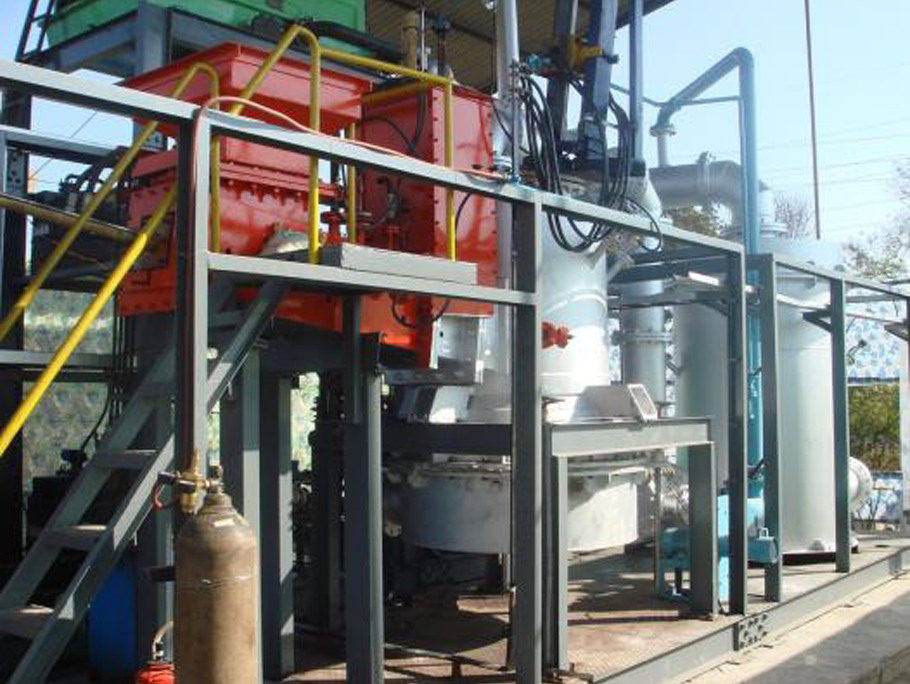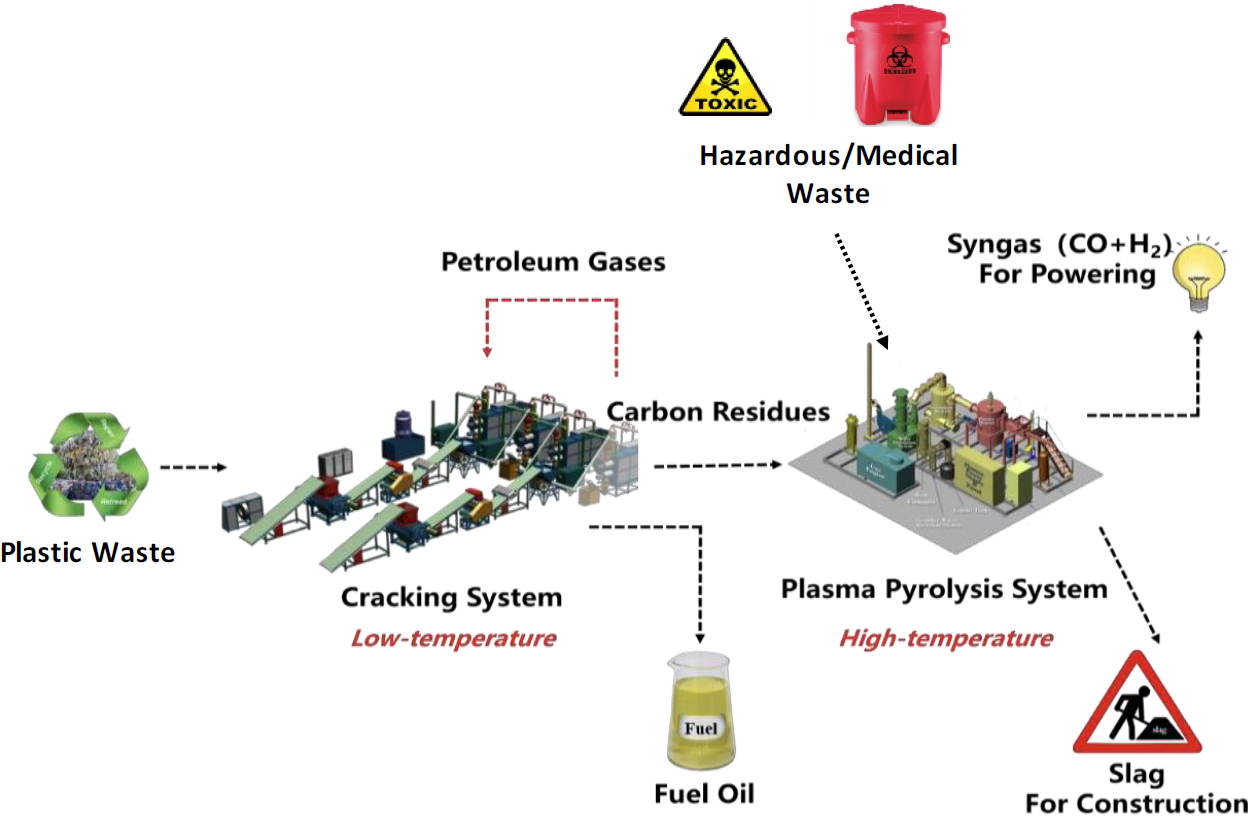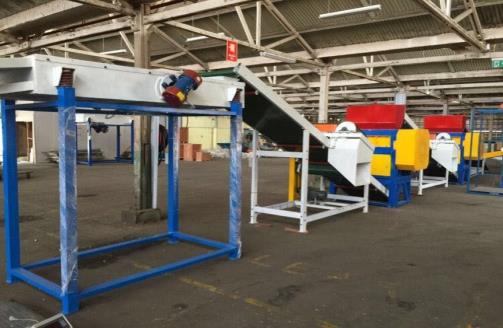SOLUTION
FTPT SYSTEMUsing the Company’s proprietary Frontier Thermal Plasma Technology (“FTPT”), the Company is able to produce the following four end-products by processing waste feedstocks in an environmentally benign process:
•Liquid fuel (diesel)
• •A clean synthetic gas (“syngas”) that is a valuable source of alternative energy (Approximate heat value: 8 to 10 MJ/Nm3, ~250 MMBTU/SCF)
• •An inert vitrified glass matrix that has excellent applications in the construction industry;
•• Recovered metal mixtures or metal alloys.
Frontier’s FTPT results in All feedstock is 100% waste diversion of all feedstock thereby eliminating any landfill requirements and/or further processing, while producing zero greenhouse gas emissions.


The innovative core technology Frontier uses is heat generated by plasma-arcs in an oxygen deprived (pyrolysis) environment to first dissociate the molecules that make-up the organic portions of the waste, then, depending on the composition of the waste stream, a controlled (stoichiometric) amount of oxygen is added to reform the dissociated elements of the waste into a synthesis gas ("syngas"), consisting mainly of Carbon Monoxide (CO) and Hydrogen (H2). The syngas can then be used in a variety of ways: as a fuel for thermal and/or electricity production or as a feedstock to produce liquid fuels, such as ethanol.
Waste, when heated to a very high temperature in the controlled atmosphere of the plasma reactor undergoes predictable physical and chemical changes. This high temperature, over 1,000°C (1,800°F) prevents the formation of complex organic molecules and breaks down organics into a gas. These primary molecules are stable above 965°C (1,770°F). The gas is then fed through a gas cleaning and conditioning system where it is rapidly cooled and cleaned to remove any entrained particulate and/or acid gases prior to potential re-use.
Any inorganic constituents of the waste are melted (vitrified) into an environmentally safe, leach resistant, glass matrix. Frontier plasma reactors are designed to collect the molten metal and glass. The glass and metal layers are removed through controllable tap ports into a slag/metal collection system. Removal of the molten glass or metals presents no hazards of any kind to personnel, requires no special tools and does not disrupt the operating process. The metal layer settles on the bottom of the basin in the processing reactor below the molten glass. Both layers are tapped as necessary, depending on the metal/inorganic content of the waste stream.
The vitrified product can be used in a variety of commercial applications including concrete aggregate, insulation, roadbed construction, and even in decorative tiles. The metal layer can contain relatively pure amounts of iron, copper and aluminum.
FTPT systems are driven by proprietary, state-of-the-art instrumentation and computerized control systems. The FTPT process is a unique, cost-effective and environmentally effective technology that is superior to other mainstream methods of waste treatment:
The FTPT process can utilize virtually any type of feedstock containing combinations of organic, inorganic and/or heavy-metal constituents. Thus, the pre-processing, staging and management costs are minimized thereby reducing processing costs and enhancing recycling profitability margins.
Unlike incineration or metal-bearing waste stabilization, the FTPT process is designed not to create any secondary solid wastes that will require further treatment or landfilling. As previously mentioned, stand-alone incinerators produce large quantities of bottom and fly ash which are toxic in nature, require further treatment (with stabilization agents) and the resulting post-treated materials (often time whose volume has been doubled) will require final disposal, sometimes in specially designed hazardous waste landfills.
LTPT SYSTEM


Frontier OEM’s third party manufacturer’s Low Temperature Pyrolysis Technology (between 350°C to 500° C) to break long hydrocarbon chains of plastic wastes to reform liquid fuel (heavy oil and, through distillation, diesel) with catalyst. Feedstock is automatically and continuously being fed into the LTPT. The LTPT system produces three primary products: petroleum gases which can be recycled back into the system providing a power supply; fuel oil, which can be used to fuel generators; and, a small amount of carbon residues, may be directly fed into FTPT plasma pyrolysis system. Feeding the carbon residues into the FTPT eliminates the residues thereby avoiding any landfill requirements for the waste. The block diagram below depicts the combination of an FTPT and LTPT system and the resulting production of fuel, syngas and slag.
TopConventions:

- Basel Convention on the Control of Transboundary Movements of Hazardous Wastes and Their Disposal
- Stockholm Convention on Persistent Organic Pollutants
- United Nations Framework Convention on Climate Change (UNFCCC)
- Vienna Convention for the Protection of the Ozone Layer
- Montreal Protocolon Substances at Deplete the Ozone Layer
- Kyoto Protocol
- Convention on the Prevention of Marine Pollution by Dumping of Wastes and Other Matter
- Convention on Long-Range Transboundary Air Pollution
- U.S.-Canada Air Quality Agreement
Parteners
 Cielo Holding LLC
Cielo Holding LLC